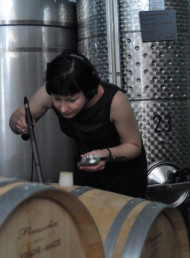Trending: Neurogastronomy
Photography by Alice Harbourne .

It's always been said we eat with our eyes, but to what degree do our other senses come into play? Olivia Atkinson investigates the neurogastronomy trend...
Have you ever eaten your favourite restaurant dish from a takeaway container? The experience is almost always less pleasant. As with most things, science has stepped in to explain why. It’s a mouthful of a term, but neurogastronomy is set to change the way we approach and think about eating.
The man at the forefront of this new, quirky concept is Oxford psychologist Charles Spence. Dubbed as one of the fathers of neurogastronomy and a mad scientist of sorts, Spence studies how factors such as textures, aromas, colours and sounds affect the way we experience food. In his own words, “We see it, we hear it, we smell it, we taste it, we feel it. All those senses come together.” This harmonious collaboration allows the brain to pick up and interpret what we know as ‘flavour’.
Armed with this knowledge, chefs are testing the neurogastronomic waters. Eating is a symphony created by a multi-sensory orchestra and every meal has a different score.
In a bid to bring the concept to life, Spence joined forces with molecular wizard Heston Blumenthal. Together they created the iconic dish “Sound of the Sea” for Bleumenthal’s three Michelin-starred restaurant, Fat Duck. Famously, the dish mimics elements of the ocean including edible sand and shellfish 'sea foam', and is accompanied by an iPod loaded with sounds of seagulls and the lapping of waves, designed to enhance seafood flavours.
This pioneering approach to dining has given food enthusiasts a platform for experimentation. In early 2010, legendary Spanish chef Ferran Adrià opened the elBulli Foundation, a centre of innovation for haute cuisine. His approach to this venture was aligned with his belief that gastronomy is a creative science, fuelled by the fostering of ideas.
Working alongside Spence, Adrià stumbled upon the finding that strawberry-based desserts taste ten per cent sweeter if eaten from a white plate than from a black one. Similarly, London-based drink giants, Diageo, tinkered with atmosphere when drinking single-malt whiskey. Fresh grass and birdsong made the whiskey taste “grassier,” whereas red lighting, curved furniture and jingling bells gave the drink a sweeter flavour.
Closer to home, Gianpaolo Grazioli (Giapo) has been experimenting with neurogastromy in the context of gourmet ice cream at his flagship Auckland store. An AUT science graduate himself, in 2012 he worked with a fellow student to build 'The Dome' - a cone of sensory experimentation, invented with the lofty goal of determining whether there is such thing as universal taste.

Customers were given flavoured ice creams in combination with various sensory stimuli. In this small-scale experiment, definite trends became apparent - reggae went well with lemon sorbet; rock music was only tolerated with hazelnut affogato, and the combination of a video of Bach's Air on a G String with chocolate ice cream was overwhelmingly popular. "I bizarrely found that even if people weren't enjoying the food itself, alongside the right music and/or video, they found the whole experience pleasant", Giapo concludes.
The Dome has recently been donated to the AUT food science department, and Giapo hopes that funding will go into further experimentation. The confines of his street-side store means he's limited as to what neurogastronomic tricks he can currently implement, but he still manages in small ways. Each ice cream is served with a spritz of fragrant essential oil, and customers order from a menu before seeing what the ice cream will look like - a process Giapo believes positively alters taste perception.
Neurogastronomy is on the radar as one of the hottest trends of 2015 as its philosophies begin to enter the mainstream. In restaurant consulting firm Baum + Whiteman’s annual report, the scientific phenomenon was described as “all about how our senses cumulatively react to food, and how to profitably manipulate those senses.” Next time you eat out, consciously note what you can smell, feel, hear and see - it may be having a bigger impact on the size of the bill than you think...
latest issue:
Issue #120
As the days become shorter, and the nights cooler, the latest issue is perfectly timed to deliver delicious autumn dishes. From recipes using fresh seasonal produce such as feijoas and apples, to spectacular soothing soups and super-quick after-work meals in our Food Fast section, we’ve got you covered. With Easter on the horizon, we feature recipes that will see you through breakfast, lunch and dinner over a leisurely weekend holiday, and whip up chocolatey baking treats sure to please. We round up delicious dinners for two and showcase a hot new Korean cookbook before heading south to Dunedin to check out all that’s new in food and dining.The latest issue of dish is on sale NOW at all good bookstores and supermarkets – don’t miss it!


